+ Open data
Open data
- Basic information
Basic information
| Entry | Database: PDB / ID: 1mh0 | ||||||
|---|---|---|---|---|---|---|---|
| Title | Crystal structure of the anticoagulant slow form of thrombin | ||||||
 Components Components | Prothrombin | ||||||
 Keywords Keywords | BLOOD CLOTTING / thrombin / allostery / sodium binding / serine protease | ||||||
| Function / homology |  Function and homology information Function and homology informationcytolysis by host of symbiont cells / thrombospondin receptor activity / Defective factor XII causes hereditary angioedema / thrombin / thrombin-activated receptor signaling pathway / negative regulation of astrocyte differentiation / regulation of blood coagulation / positive regulation of phospholipase C-activating G protein-coupled receptor signaling pathway / neutrophil-mediated killing of gram-negative bacterium / Defective F8 cleavage by thrombin ...cytolysis by host of symbiont cells / thrombospondin receptor activity / Defective factor XII causes hereditary angioedema / thrombin / thrombin-activated receptor signaling pathway / negative regulation of astrocyte differentiation / regulation of blood coagulation / positive regulation of phospholipase C-activating G protein-coupled receptor signaling pathway / neutrophil-mediated killing of gram-negative bacterium / Defective F8 cleavage by thrombin / Platelet Aggregation (Plug Formation) / ligand-gated ion channel signaling pathway / positive regulation of collagen biosynthetic process / negative regulation of platelet activation / negative regulation of blood coagulation / positive regulation of blood coagulation / negative regulation of fibrinolysis / regulation of cytosolic calcium ion concentration / Transport of gamma-carboxylated protein precursors from the endoplasmic reticulum to the Golgi apparatus / Gamma-carboxylation of protein precursors / Common Pathway of Fibrin Clot Formation / Removal of aminoterminal propeptides from gamma-carboxylated proteins / fibrinolysis / Intrinsic Pathway of Fibrin Clot Formation / negative regulation of proteolysis / negative regulation of cytokine production involved in inflammatory response / Peptide ligand-binding receptors / Regulation of Complement cascade / positive regulation of release of sequestered calcium ion into cytosol / acute-phase response / Cell surface interactions at the vascular wall / positive regulation of receptor signaling pathway via JAK-STAT / growth factor activity / lipopolysaccharide binding / positive regulation of insulin secretion / platelet activation / response to wounding / positive regulation of protein localization to nucleus / Golgi lumen / Regulation of Insulin-like Growth Factor (IGF) transport and uptake by Insulin-like Growth Factor Binding Proteins (IGFBPs) / positive regulation of reactive oxygen species metabolic process / blood coagulation / antimicrobial humoral immune response mediated by antimicrobial peptide / regulation of cell shape / heparin binding / Thrombin signalling through proteinase activated receptors (PARs) / : / positive regulation of cell growth / blood microparticle / G alpha (q) signalling events / cell surface receptor signaling pathway / positive regulation of phosphatidylinositol 3-kinase/protein kinase B signal transduction / receptor ligand activity / endoplasmic reticulum lumen / signaling receptor binding / serine-type endopeptidase activity / positive regulation of cell population proliferation / calcium ion binding / proteolysis / extracellular space / extracellular exosome / extracellular region / plasma membrane Similarity search - Function | ||||||
| Biological species |  Homo sapiens (human) Homo sapiens (human) | ||||||
| Method |  X-RAY DIFFRACTION / X-RAY DIFFRACTION /  SYNCHROTRON / SYNCHROTRON /  MOLECULAR REPLACEMENT / Resolution: 2.8 Å MOLECULAR REPLACEMENT / Resolution: 2.8 Å | ||||||
 Authors Authors | Pineda, A.O. / Savvides, S. / Waksman, G. / Di Cera, E. | ||||||
 Citation Citation |  Journal: J.Biol.Chem. / Year: 2002 Journal: J.Biol.Chem. / Year: 2002Title: Crystal structure of the anticoagulant slow form of thrombin Authors: Pineda, A.O. / Savvides, S. / Waksman, G. / Di Cera, E. | ||||||
| History |
|
- Structure visualization
Structure visualization
| Structure viewer | Molecule:  Molmil Molmil Jmol/JSmol Jmol/JSmol |
|---|
- Downloads & links
Downloads & links
- Download
Download
| PDBx/mmCIF format |  1mh0.cif.gz 1mh0.cif.gz | 123.6 KB | Display |  PDBx/mmCIF format PDBx/mmCIF format |
|---|---|---|---|---|
| PDB format |  pdb1mh0.ent.gz pdb1mh0.ent.gz | 97.1 KB | Display |  PDB format PDB format |
| PDBx/mmJSON format |  1mh0.json.gz 1mh0.json.gz | Tree view |  PDBx/mmJSON format PDBx/mmJSON format | |
| Others |  Other downloads Other downloads |
-Validation report
| Summary document |  1mh0_validation.pdf.gz 1mh0_validation.pdf.gz | 462.7 KB | Display |  wwPDB validaton report wwPDB validaton report |
|---|---|---|---|---|
| Full document |  1mh0_full_validation.pdf.gz 1mh0_full_validation.pdf.gz | 486.1 KB | Display | |
| Data in XML |  1mh0_validation.xml.gz 1mh0_validation.xml.gz | 25.9 KB | Display | |
| Data in CIF |  1mh0_validation.cif.gz 1mh0_validation.cif.gz | 35 KB | Display | |
| Arichive directory |  https://data.pdbj.org/pub/pdb/validation_reports/mh/1mh0 https://data.pdbj.org/pub/pdb/validation_reports/mh/1mh0 ftp://data.pdbj.org/pub/pdb/validation_reports/mh/1mh0 ftp://data.pdbj.org/pub/pdb/validation_reports/mh/1mh0 | HTTPS FTP |
-Related structure data
| Related structure data | 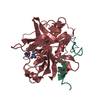 1ppbS S: Starting model for refinement |
|---|---|
| Similar structure data |
- Links
Links
- Assembly
Assembly
| Deposited unit | 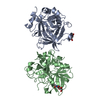
| ||||||||||
|---|---|---|---|---|---|---|---|---|---|---|---|
| 1 | 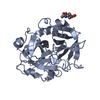
| ||||||||||
| 2 | 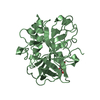
| ||||||||||
| Unit cell |
|
- Components
Components
| #1: Protein | Mass: 33007.875 Da / Num. of mol.: 2 / Mutation: R77aA Source method: isolated from a genetically manipulated source Source: (gene. exp.)  Homo sapiens (human) / Organ: blood / Plasmid: HPC4-pNUT / Organ (production host): kidney / Production host: Homo sapiens (human) / Organ: blood / Plasmid: HPC4-pNUT / Organ (production host): kidney / Production host:  #2: Sugar | #3: Water | ChemComp-HOH / | Has protein modification | Y | |
|---|
-Experimental details
-Experiment
| Experiment | Method:  X-RAY DIFFRACTION / Number of used crystals: 1 X-RAY DIFFRACTION / Number of used crystals: 1 |
|---|
- Sample preparation
Sample preparation
| Crystal | Density Matthews: 2.7 Å3/Da / Density % sol: 54.39 % | ||||||||||||||||||||||||||||||||||||
|---|---|---|---|---|---|---|---|---|---|---|---|---|---|---|---|---|---|---|---|---|---|---|---|---|---|---|---|---|---|---|---|---|---|---|---|---|---|
| Crystal grow | Temperature: 298 K / Method: vapor diffusion, hanging drop / pH: 7.6 Details: PEG 2000-Monomethyl ether, Tris-Cl, pH 7.6, VAPOR DIFFUSION, HANGING DROP at 298K | ||||||||||||||||||||||||||||||||||||
| Crystal grow | *PLUS Temperature: 25 ℃ / pH: 7.4 / Method: vapor diffusion | ||||||||||||||||||||||||||||||||||||
| Components of the solutions | *PLUS
|
-Data collection
| Diffraction | Mean temperature: 100 K |
|---|---|
| Diffraction source | Source:  SYNCHROTRON / Site: SYNCHROTRON / Site:  APS APS  / Beamline: 19-BM / Wavelength: 0.978 Å / Beamline: 19-BM / Wavelength: 0.978 Å |
| Detector | Type: ADSC QUANTUM 4 / Detector: CCD / Date: Mar 23, 2002 / Details: mirrors |
| Radiation | Monochromator: Si 111 CHANNEL / Protocol: SINGLE WAVELENGTH / Monochromatic (M) / Laue (L): M / Scattering type: x-ray |
| Radiation wavelength | Wavelength: 0.978 Å / Relative weight: 1 |
| Reflection | Resolution: 2.8→30 Å / Num. obs: 16577 / % possible obs: 90.9 % / Observed criterion σ(F): 2 / Observed criterion σ(I): 1 / Biso Wilson estimate: -0.5 Å2 |
| Reflection | *PLUS Highest resolution: 2.8 Å / Lowest resolution: 30 Å / Num. measured all: 70807 / Rmerge(I) obs: 0.111 |
| Reflection shell | *PLUS % possible obs: 78 % / Rmerge(I) obs: 0.453 / Mean I/σ(I) obs: 1.8 |
- Processing
Processing
| Software |
| |||||||||||||||||||||||||
|---|---|---|---|---|---|---|---|---|---|---|---|---|---|---|---|---|---|---|---|---|---|---|---|---|---|---|
| Refinement | Method to determine structure:  MOLECULAR REPLACEMENT MOLECULAR REPLACEMENTStarting model: PDB Entry 1PPB Resolution: 2.8→29.75 Å / Rfactor Rfree error: 0.008 / Isotropic thermal model: RESTRAINED / Cross valid method: THROUGHOUT / σ(F): 0 / Stereochemistry target values: Engh & Huber Details: The mismatched residues R75, K145, K240 (A chain) and K145 (B chain) were modelled as Alanines due to poor electron density
| |||||||||||||||||||||||||
| Solvent computation | Solvent model: FLAT MODEL / Bsol: 20.6116 Å2 / ksol: 0.320496 e/Å3 | |||||||||||||||||||||||||
| Displacement parameters | Biso mean: 38.9 Å2
| |||||||||||||||||||||||||
| Refine analyze | Luzzati coordinate error free: 0.48 Å / Luzzati sigma a free: 0.74 Å | |||||||||||||||||||||||||
| Refinement step | Cycle: LAST / Resolution: 2.8→29.75 Å
| |||||||||||||||||||||||||
| Refine LS restraints |
| |||||||||||||||||||||||||
| LS refinement shell | Resolution: 2.8→2.98 Å / Rfactor Rfree error: 0.039 / Total num. of bins used: 6
| |||||||||||||||||||||||||
| Xplor file |
| |||||||||||||||||||||||||
| Refinement | *PLUS Highest resolution: 2.8 Å / Lowest resolution: 30 Å | |||||||||||||||||||||||||
| Solvent computation | *PLUS | |||||||||||||||||||||||||
| Displacement parameters | *PLUS | |||||||||||||||||||||||||
| Refine LS restraints | *PLUS
|
 Movie
Movie Controller
Controller



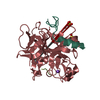

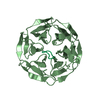
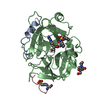
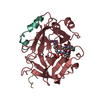

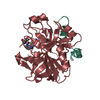

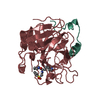
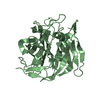
 PDBj
PDBj











